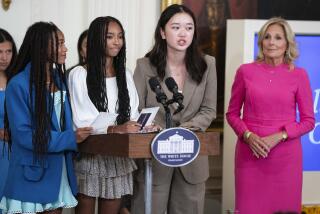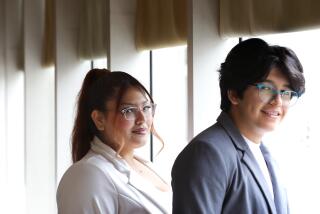BREA : School Peer Counseling Wins Praise
- Share via
After attending three high schools in four years, 18-year old Courtney Walsh felt she had the perfect resume for the job.
“I know how it is to be alone out there. I know what kids go through,” she said.
The job that Walsh is after carries a rather fancy title--conflict manager. In reality, it just means a teen-ager helping another teen-ager.
And the pay is often a simple smile of thanks.
A senior, Walsh was one of about 50 Brea-Olinda High School students who attended an orientation this week for volunteers serving the school’s Conflict Management and Peer Assistance program.
The 2-year-old program revolves around the philosophy that teen-agers with problems would rather talk to fellow teens than adults.
Peer assistants help classmates and friends deal with personal problems. They intervene when students are not speaking to one another. Sometimes they break up fights or prevent potential fights.
At Brea-Olinda, the effort has been so successful over the past two years that it was recently named the best school mental health program in Orange County by Charter Oak Hospital in Covina. The hospital awarded the school a $2,500 grant.
The program is also one of the creative ways the school has responded to budget cuts. Last year, one counselor position was cut and volunteers from the program provided badly needed help.
“Students can never take the place of professional counselors, but it does help. It’s amazing how many problems we solved,” said Dori Barnett, the school psychologist, who oversees the peer program with the remaining school counselor, Gerri Gordon.
To become a peer counselor, applicants must be recommended by at least three teachers. They fill out applications that ask them about their own personalities, and what will make them good counselors.
The application also includes a question on what the volunteer hopes to contribute--and gain--from the program.
Once selected, volunteers undergo training in communication skills, listening skills, problem solving and negotiating. Follow-up training will be conducted throughout the school year, Barnett said.
Barnett said there are no gang problems in the school but racial problems are starting to emerge. This year, an ethnic advisory council will be added, she said.
Josh Hinson, 16, a volunteer for the last two years, said the program helped him with his personal life as well.
“It’s a lot of fun. It helped me deal with my friends,” he said.
Seniors ClareClimaco and Megha Agarwal, both 17, said learning communications skills as peer counselors helped them deal with their families.
Climaco’s parents came from the Philippines while Agarwal’s came from India. Both girls say their parents preferred to suppress conflicts at home rather than discuss them.
“If my family is presented with a problem, it’s swept under the rug. Hopefully, I can help deal with problems more openly,” Climaco said.
“When I discuss problems with my family, we just yell at each other,” Agarwal said. “It’s frustrating. Sometimes they just shut me up and say, ‘End of conversation. Period.’ ”
But Agarwal said the program helped her understand herself better.
“Teen-agers have a lot of problems. It’s good to know you’re not alone,” she said.
More to Read
Sign up for Essential California
The most important California stories and recommendations in your inbox every morning.
You may occasionally receive promotional content from the Los Angeles Times.













